Chlorides in Catalysis: An Overview
Introduction
Catalysis plays a pivotal role in modern chemistry and industry, enabling efficient and selective chemical transformations. Among the diverse range of catalysts, chlorides are particularly noteworthy due to their versatility and effectiveness. This article explores the role of chloride compounds in catalysis. Hope that you can learn about their applications, benefits, and challenges.

Main Types of Chloride Catalysts
1. Aluminum Chloride (AlCl₃)
Aluminum chloride is a powerful Lewis acid, widely used in catalysis. Its primary application is in the Friedel-Crafts reactions, where it catalyzes the alkylation and acylation of aromatic compounds. This process is fundamental in the production of fine chemicals, pharmaceuticals, and polymers. Additionally, AlCl₃ is employed in the isomerization and polymerization of hydrocarbons, making it indispensable in petrochemical industries.
2. Cobalt Chloride (CoCl₂)
Cobalt chloride is a versatile catalyst used in several significant processes. One of its key applications is in hydroformylation, where it converts alkenes into aldehydes, which are precursors to alcohols, acids, and other chemicals. In the Fischer-Tropsch synthesis, CoCl₂ catalyzes the conversion of syngas (a mixture of hydrogen and carbon monoxide) into hydrocarbons, playing a crucial role in synthetic fuel production.
3. Iron Chlorides (FeCl₂ and FeCl₃)
Iron chlorides are essential in both industrial and environmental applications. They are commonly used in water treatment processes, where they act as coagulants to remove impurities. In organic synthesis, iron chlorides serve as catalysts for various reactions, including chlorination and oxidation.
4. Copper Chloride (CuCl and CuCl₂)
Copper chlorides are particularly important in the oxychlorination process, which is used to produce vinyl chloride, the monomer for polyvinyl chloride (PVC). Additionally, copper chlorides are involved in redox reactions in both organic and inorganic synthesis, contributing to the production of a wide array of chemicals.
Mechanisms and Functionality
The catalytic activity of chlorides can be attributed to several key mechanisms:
- Lewis Acidity: Many chloride catalysts, such as aluminum chloride, function as Lewis acids. They accept electron pairs from reactants, facilitating the formation of new bonds. This property is particularly useful in organic synthesis, where it enhances the reactivity of substrates.
- Redox Activity: Transition metal chlorides, including cobalt and iron chlorides, participate in redox reactions. They alternate between different oxidation states, driving chemical transformations by transferring electrons.
- Coordination Complexes: Metal chlorides can form coordination complexes with organic molecules. These complexes stabilize reaction intermediates, improving reaction rates and selectivity.
Applications of Chlorides
1. Petrochemical Industry
Chloride catalysts are indispensable in the petrochemical industry. They are used in refining processes to improve the quality and yield of fuels and lubricants. For instance, aluminum chloride is used in the alkylation of hydrocarbons, producing high-octane gasoline.
2. Polymer Production
Copper chloride is crucial in the production of PVC, one of the most widely used plastics. The oxychlorination process, catalyzed by CuCl₂, converts ethylene into vinyl chloride monomers, which are then polymerized to form PVC.
3. Pharmaceuticals and Fine Chemicals
Chloride catalysts enable the synthesis of complex molecules in the pharmaceutical and fine chemicals industries. Their ability to facilitate a wide range of reactions makes them valuable tools for producing active pharmaceutical ingredients and specialty chemicals.
4. Environmental Applications
Iron chlorides are widely used in water treatment processes. They act as coagulants, helping to remove impurities from water, ensuring safe and clean water supplies. Additionally, they are used in waste treatment processes to precipitate heavy metals and other contaminants.
5. Renewable Energy
Cobalt chloride plays a crucial role in renewable energy applications. In the Fischer-Tropsch synthesis, it catalyzes the production of synthetic fuels from syngas, contributing to the development of alternative energy sources.
Advantages of Chloride Catalysts
Chloride catalysts offer several advantages in various chemical reactions and industrial processes. Here are some key benefits:
- High Efficiency:
Chloride catalysts are known for their high catalytic efficiency and selectivity. This efficiency makes them particularly effective for a wide range of chemical reactions, ensuring that desired products are obtained in high yields with minimal by-products. For example, aluminum chloride (AlCl₃) is a powerful catalyst in Friedel-Crafts reactions, enabling the efficient synthesis of complex organic molecules.
- Versatility:
Chloride catalysts are highly versatile, capable of catalyzing a diverse array of reactions, including alkylation, acylation, hydroformylation, and polymerization. This versatility makes them valuable in various industrial applications, from the production of high-octane gasoline to the synthesis of fine chemicals and pharmaceuticals. For instance, cobalt chloride (CoCl₂) is instrumental in both hydroformylation and Fischer-Tropsch synthesis, highlighting its multifaceted utility.
- Availability:
Many chloride compounds are readily available and relatively inexpensive. This widespread availability contributes to their extensive use in industrial processes. The cost-effectiveness of chloride catalysts, such as iron chloride (FeCl₃) in water treatment and aluminum chloride in organic synthesis, makes them accessible for large-scale applications.
Environmental and Safety Considerations
The use of chloride catalysts necessitates careful consideration of environmental and safety issues. Aluminum chloride is highly corrosive and can cause severe burns, requiring protective equipment and dry handling conditions. Cobalt chloride poses toxicity concerns, necessitating proper ventilation and protective gear. Additionally, the disposal of chloride catalysts must adhere to environmental regulations to prevent contamination.
Future Directions
Research continues to explore new chloride catalysts with improved performance and reduced environmental impact. Innovations in catalyst design, such as supported and nanostructured chloride catalysts, aim to enhance catalytic activity and selectivity while minimizing drawbacks. The development of green chemistry approaches and sustainable practices is also a significant focus, aiming to reduce the environmental footprint of catalytic processes.
Conclusion
Chlorides play a crucial role in catalysis, driving essential industrial processes and enabling the synthesis of a wide range of chemicals. While they offer significant advantages, their use requires careful consideration of safety, handling, and environmental impact. Advances in catalyst technology promise to further enhance the benefits of chloride catalysts, paving the way for more efficient and sustainable chemical processes in the future. For more information, please check Stanford Advanced Materials (SAM).




